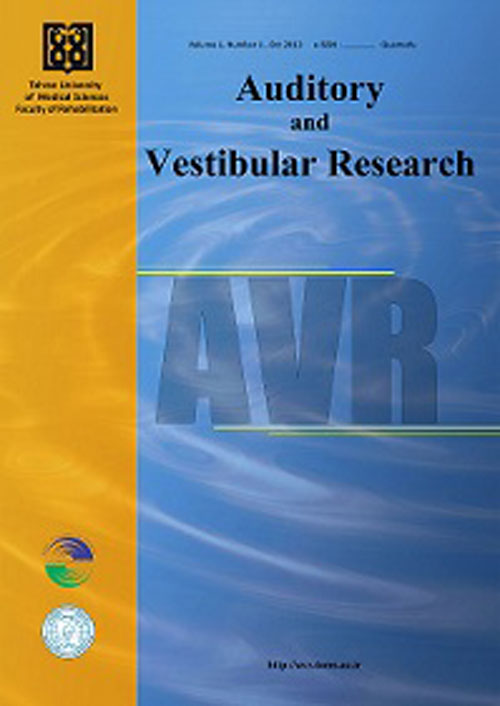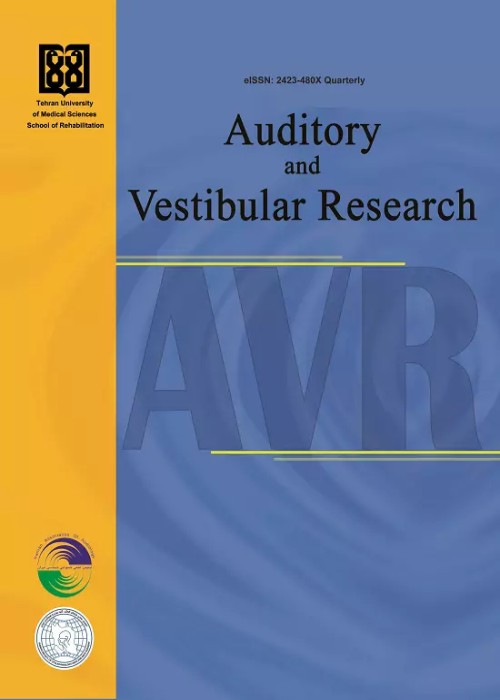فهرست مطالب

Auditory and Vestibular Research
Volume:26 Issue: 2, Spring 2017
- تاریخ انتشار: 1396/02/20
- تعداد عناوین: 8
-
-
Pages 56-63Background And AimSpatial hearing is one of the most important functions of binaural hearing processing that is based on detection of fine interaural time and interaural intensity difference. Spatial hearing is beyond auditory localization and lateralization. It helps auditory scene analysis and target stream segregation from other simultaneous sound sources. This function is important in speech perception in presence of competing messages. The aim of the present paper was reviewing spatial hearing, plasticity of binaural hearing in auditory system and spatial hearing disorder in children with central auditory processing disorder ((C)APD).Recent FindingsRecent studies show that spatial hearing disorder is one of the important problems in relatively high proportion of children with (C)APD. It is proposed that spatial processing disorder can cause speech perception difficulty in noise which is the main complaint of children with (C)APD. Spatial hearing rehabilitation through sound localization and lateralization training can be effective in improvement of speech perception in noise.ConclusionIn children suspected to (C)APD, spatial hearing evaluation is vital. Spatial hearing can be evaluated by using sound localization and lateralization tests. If spatial hearing disorder is detected, special rehabilitation is necessary to address this central processing problem. This rehabilitation has a potential to improve speech perception in noise.Keywords: Central auditory processing, spatial hearing, speech perception in noise, sound localization, pediatrics
-
Pages 64-70Background And AimMultiple sclerosis is a chronic inflammatory disease of demyelinating lesions in the brain, spinal cord and optic nerve. One of the most debilitating symptoms of multiple sclerosis (MS) patients is impaired balance. Thus in people with MS, collecting information about the impact of impaired balance on life style and the disability which is being perceived by the patient is essential and its information cannot solely be achieved through any of balance and functional tests. The aim of this study was to assess the validity and reliability of Persian version of the Activities-specific Balance Confidence (ABC-P) scale in patients with MS.MethodsA hundred and sixty two patients aged between 20 to 50 years old with MS disorder were examined. To analyze the data, Lawshe method, content validity ratio (CVR), content validity index (CVI), test-retest reliability, and internal consistency reliability were utilized.ResultsIntraclass correlation coefficient (ICC), and Cronbach's alpha coefficients were 0.93, 0.97, 0.96 and 0.97, respectively.ConclusionABC-P scale has essential validity and reliability in people who are suffering from multiple sclerosis among Iranian society.Keywords: Multiple sclerosis, reliability, validity, activities-specific balance confidence scale
-
Pages 71-85Background And AimSelf-administered questionnaires are clinically important to document how tinnitus affects the daily life of patients. In this regard, there is a need to have an alternative questionnaire that covers relevant aspects of tinnitus and related symptoms. The present study aimed to develop and validate a new tinnitus questionnaire known as Tinnitus Handicap Questionnaire or Borang Evaluasi Soal selidik Tinitus (BEST) in Malay version.MethodsThe present study had two consecutive phases. In phase 1 of study, BEST questionnaire was initially developed in English and underwent forward and backward translation processes. Following relevant amendments, the final version of BEST (Malay version) was ready for subsequent tasks. It consists of 25 items categorized under 3M domain (mind, main and mental). In phase 2, 65 patients with tinnitus were recruited for determining the validity and reliability of BEST.ResultsContent validity index (CVI) of BEST ranged from 0.71-1.00. Endorsement rates of BEST were acceptable (0.05) implying good construct validity.ConclusionThe BEST questionnaire has been proven valid and reliable to be used clinically, particularly among Malay-speaking population. Nevertheless, future studies are welcome to further support the findings obtained from the present study.Keywords: Tinnitus, questionnaire, psychometric, validity, reliability
-
Pages 86-92Background And AimChildren with special needs such as those with hearing loss, visual impairment, mental retardation, and physical-motor disability have special conditions, which may adversely affect their parents mental health. Given the importance of this issue, the present study aimed to investigate and compare the components of quality of life and psychological well-being in mothers of children with hearing loss, visual impairment, mental retardation, and physical-motor disability.MethodsThis was a descriptive, retrospective study. The statistical population included all mothers of children with special needs. The participants of this study were 200 mothers of children with special needs that were divided into four groups of hearing loss, visual impairment, mental retardation, and physical-motor disability in Isfahan. The mothers were selected through stratified random sampling. Data were collected using quality of life and psychological well-being questionnaires.ResultsIn terms of quality of life, there was a statistically significant difference between mothers of children with hearing loss and mothers of children with mental retardation and physical-motor disability (p0.05).ConclusionAlthough the quality of life in both groups of mothers of hearing and visually impaired children was higher than that of mothers of children with mental retardation and physical-motor disability, the physical and mental health of these mothers should be taken into consideration.Keywords: Psychological well-being, hearing loss, children with special needs, quality of life, mothers
-
Pages 93-98Background And AimAuditory processing disorder (APD) weakens recognition and understanding auditory data and adversely affects children's language and learning if remains undetected and untreated. Since early diagnosis of APD can obviate its adverse effects, screening is hugely important in identifying suspected cases. Auditory Processing Domain Questionnaire (APDQ) is a reliable tool among APD screening methods. The present study aimed to translate and to determine the validity and reliability of APDQ.MethodsThe first phase included translation of APDQ into Persian according to international quality of life assessment (IQOLA) method including forward translation, assessment of translation, and backward translation. The second phase involved establishing face and content validities and reliability of the Persian version of APDQ.ResultsAll the items had appropriate quality in terms of translation difficulty following review of 5 items and had appropriate translation quality after review of 21 items. In terms of face validity, more than 80% of the participants gave a score of 4 or higher to the items. In content validity, content validity ratio exceeded 63% in all the items. In determining reliability, Cronbach's alpha in subscales of 1-3 was found to be 0.88, 0.80, and 0.86, respectively. Intraclass correlation coefficient for each of the three subscales was higher than 0.92.ConclusionThe Persian version of APDQ has favorable translation quality, validity, and reliability. The Persian version of APDQ can be used for screening of auditory processing skills in 8 to 12-year-old children.Keywords: Auditory processing disorder ques¬tionnaire, screening, validity, reliability
-
Pages 99-104Background And AimThe speech intelligibility is evaluated through the perceptual and acoustic methods. In the perceptual method, the speech intelligibility is investigated using the listeners judgment. On the other hand, in the acoustic method, the acoustic parameters related to speech are studied. This study aimed to evaluate the association between the suprasegmental components and perceptual speech intelligibility through investigating the correlation between the mean duration of speech at the word level with the percentage of speech intelligibility in children with cochlear implant.MethodsThis study was conducted on 18 children with cochlear implant within the age range of 4-6 years. The participants were asked to repeat 30 selected Persian words displayed in a video show while their voices were recorded by a microphone. The evaluation of perceptual speech intelligibility was performed using the judgment of three listeners who were unfamiliar with the speech of the hearing impaired children. The speech duration was calculated through the Praat software version 5.2.25.ResultsAccording to the results, the mean of words duration was 0.5140±0.098 seconds and the mean percentage of the perceptual intelligibility of the selected words was 47.78%. Furthermore, the speech duration was significantly correlated with perceptual speech intelligibility (pConclusionThe speech duration plays a prominent role in determining the speech intelligibility in the children with cochlear implant at the word level. Therefore, this method can be applied in the clinical rehabilitation programs implemented for these children to increase their speech intelligibility in an appropriate manner.Keywords: Duration, perceptual intelligibility, cochlear implant
-
Pages 105-111Background And AimSubjective visual vertical (SVV) test is a clinical tool to evaluate the utricular function and the gravity perception pathways in peripheral and central vestibular lesions. Menieres disease (MD) involves cochlear and otolithic organs. The prevalence and features of otolithic dysfunction in the acute phase of this disease are unknown. The aim of this study was to evaluate of SVV test in the acute phase of MD and to investigate the validity of SVV test for detection of otolithic disorders in MD patients.MethodsThirty two patients with unilateral definite Meniere's disease and thirty two normal subjects were enrolled in this study. Pure tone audiometry, tympanometry, and SVV test were performed.ResultsThere was no significant difference between the mean SVV in the normal group and the mean SVV in the healthy side of the patient group, while a significant difference was observed between the mean SVV in the normal group and the mean SVV in the affected side of the patient groups. Also, in the patient group, the difference in the mean SVV between the healthy and affected sides was significant.ConclusionPatients with MD have difficulties in perception of verticality that is probably due to utricular dysfunction. In order to improve the level of diagnosis of MD it is suggested to add SVV test to the test battery.Keywords: Meniere's disease, otolith, subjective visual vertical test
-
Pages 112-116Background And AimAuditory P300 is an event-related potential. Cognitive factors like attention are involved in the generation of P300. It seems that normative variation of P300 is necessary for clinical purposes. Thus, the current study was designed to establish preliminary normative variation of P300 amplitude and latency at Fz and Cz sites in adults.MethodsThis cross-sectional study was performed on 20 right-handed volunteers aged 18 to 33 years. P300 was recorded monaurally with two channels at Fz and Cz placements. Two tone bursts of 1000Hz and 2000Hz were used as frequent and target stimuli, respectively.ResultsThe mean values of P300 amplitude and latency at Cz were 7.43±2.61 µv and 325.19±21.34 ms in the right ear and 7.38±2.73µv and 320.29±21.56 ms in the left ear, respectively. At Fz, the mean values of P300 amplitude and latency were 5.34±1.74 µv and 330.09±25.58 ms in the right ear and 5.67±2.30 µv and 329.52±29.25 ms in the left ear, respectively. The differences between the ears at Cz and Fz were not statistically significant (p˃0.05).The mean value of amplitude of P300 was significantly greater at Cz than Fz (p=0.001) although the difference in latency was not statistically significant between Cz and Fz (p˃0.05).ConclusionAmplitude of P300 was greater at Cz than Fz although latency was not different. Based on these findings, amplitude and latency values can be probably used for clinical purposes to assess auditory disorders.Keywords: Adult, P300, normal hearing, event related potentials


